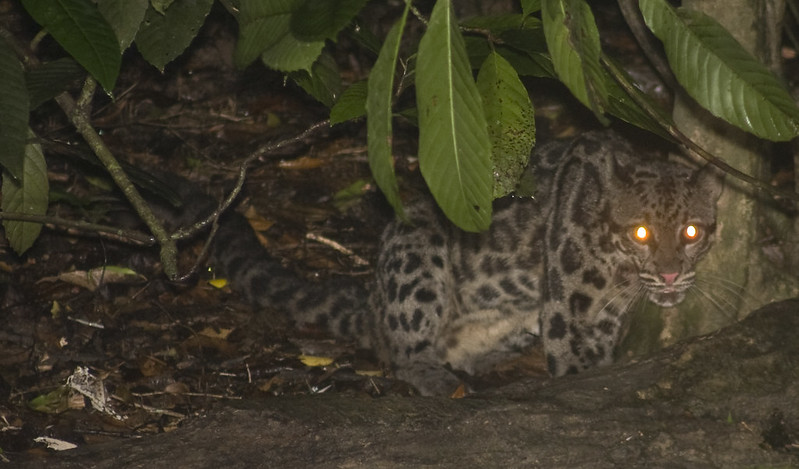The clouded leopard (Neofelis nebulosa) is a beautiful cat found in Southeast Asia, China, and Himalayan foothills. It is a slightly different species from the Sunda clouded leopard (Neofelis diardi) of Sumatra and Borneo. The Sunda clouded leopard was originally thought to be just a subspecies of the clouded leopard, but genetic analysis has since shown that the Sunda diverged into a separate species about 1.5 million years ago. It might have traveled over a once existent land bridge spanning from mainland Asia to Sumatra and Borneo. Furthermore, the Sunda species is split into two subspecies: N. diardi diardi on the island of Sumatra and N. diardi borneensis in Borneo.


The clouded leopard is the smallest of the big cats – only four to six feet including the long tail. It is named for the cloud like markings on its coat and the Sunda’s cloud spots are darker and smaller than the mainland species’. The markings provide camouflage in the dappled sunlight of its rainforest home while hunting or hiding. Clouded leopards are excellent climbers and primarily spend time up in the trees. Their legs are short to give them a lower center of gravity and their three foot long tails provide good balance. Their paws and claws are quite large and their back ankles are flexible enough to rotate backwards, allowing them to climb down a tree head first. The paw pads are special in that they can conform to the tree bark when the cat is climbing.

Clouded leopards have extremely formidable jaws, which can open up to 100 degrees. Their upper canine teeth are the longest in comparison to their skull size of any other living carnivore known. This, and other structural evidence, suggests that there is a connection between the clouded leopard and prehistoric saber-toothed cats such as Smilodon. It is possible that clouded leopards also use a similar hunting technique to saber-toothed cats. All other living big cats take down prey by attacking the throat or muzzle whereas the saber-tooth used its fangs to sever the spine, nerves, and blood vessels in the neck and strangulate the animal. This is a method that kills instantly.

Clouded leopards are cats that need help, but they are difficult to breed in captivity because there is so much aggression between the males and females. One way that was found to combat this is to introduce leopard pairs around one year old so that a successful pair bond is created and aggression is lessened. Leopards become sexually mature around two years of age. Female leopards give birth to one to five cubs in a litter, although it is most often two, and those cubs will be fully independent by ten months.

Clouded leopards are incredibly rare and elusive in the wild, so there is still not much known about them. Their habitat is threatened by rampant deforestation and they are poached for their beautiful fur as well as teeth and claws. This leopard is listed as an endangered species in the United States, which prohibits the trade of any live cats, parts, or products. Over most of its range, it remains protected, but some areas such as India, Malaysia, and Thailand have more lax and poorly enforced regulations. Breeding programs have been set up in many places around the world and the practice of introducing prospective pairs when young has shown relatively good success in recent years. In 2011, a pair of cubs was born at Tacoma’s Point Defiance Zoo and Aquarium in my home state of Washington and three were born at the Nashville Zoo in Tennessee, then four in 2012.

Let’s hope that captive breeding programs continue to be a success and more attention is given to the conservation of the clouded leopard’s habitat and life in all areas of its range.

UPDATE!!! 6/5/15
Four new clouded leopard cubs have been born at Point Defiance Zoo & Aquarium in Tacoma, Washington!
They are now officially on display, so go see them if you’re in the area! 🙂

References:
1. World Wildlife Fund. “New Species Declared: Clouded Leopard On Borneo And Sumatra.” ScienceDaily. ScienceDaily, 15 March 2007. .
2. McGinley, Mark. “Clouded Leopard.” The Encyclopedia of Earth. Ed. C. Michael Hogan. The Encyclopedia of Earth, 23 Feb. 2010. Web. 02 May 2015. .
3. “About the Clouded Leopard.” Clouded Leopard Project. Clouded Leopard Project, 2003. Web. 02 May 2015. .
4. Christiansen, Per. “Sabertooth characters in the clouded leopard (Neofelis nebulosa Griffiths 1821).” Journal of Morphology 267.10 (2006): 1186-1198.
5. “Clouded Leopard Cubs.” Welcome Our New Clouded Leopard Cubs. Point Defiance Zoo & Aquarium, June 2011. Web. 02 May 2015. .
6. “The Nashville Zoo Celebrates Two Sets of Clouded Leopard Cubs.” The Associated Press. The Associated Press, 29 Mar. 2012. Web. 02 May 2015.
Photo Links:
1.https://flic.kr/p/5qmR21
3.http://img2.timeinc.net/people/i/2013/sandbox/leopards/clouded-leopard-1-600×450.jpg
4.http://polimaty.pl/wp-content/uploads/2015/03/leop11.jpg